Environmental impact of pesticides
The impact of pesticides consists of the effects of pesticides on non-target species. Pesticides are chemical preparations used to kill fungal or animal pests. Over 98% of sprayed insecticides and 95% of herbicides reach a destination other than their target species, because they are sprayed or spread across entire agricultural fields.[1] Runoff can carry pesticides into aquatic environments while wind can carry them to other fields, grazing areas, human settlements and undeveloped areas, potentially affecting other species. Other problems emerge from poor production, transport and storage practices.[2] Over time, repeated application increases pest resistance, while its effects on other species can facilitate the pest's resurgence.[3]
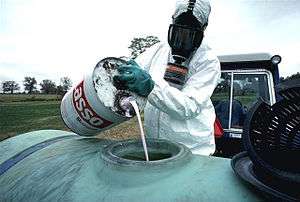
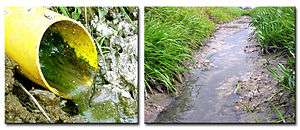
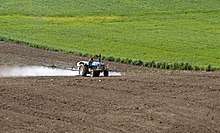
Each pesticide or pesticide class comes with a specific set of environmental concerns. Such undesirable effects have led many pesticides to be banned, while regulations have limited and/or reduced the use of others. The global spread of pesticide use, including the use of older/obsolete pesticides that have been banned in some jurisdictions, has increased overall.[4][5]
Agriculture and the environment
The arrival of humans in an area, to live or to conduct agriculture, necessarily has environmental impacts. These range from simple crowding out of wild plants in favor of more desirable cultivars to larger scale impacts such as reducing biodiversity by reducing food availability of native species, which can propagate across food chains. The use of agricultural chemicals such as fertilizer and pesticides magnify those impacts. While advances in agrochemistry have reduced those impacts, for example by the replacement of long-lived chemicals with those that reliably degrade, even in the best case they remain substantial. These effects are magnified by the use of older chemistries and poor management practices.[4][6]
History
While concern for ecotoxicology began with acute poisoning events in the late 19th century; public concern over the undesirable environmental effects of chemicals arose in the early 1960s with the publication of Rachel Carson′s book, Silent Spring. Shortly thereafter, DDT, originally used to combat malaria, and its metabolites were shown to cause population-level effects in raptorial birds. Initial studies in industrialized countries focused on acute mortality effects mostly involving birds or fish.[7]
Data on pesticide usage remain scattered and/or not publicly available (3). The common practice of incident registration is inadequate for understanding the entirety of effects.[7]
Since 1990, research interest has shifted from documenting incidents and quantifying chemical exposure to studies aimed at linking laboratory, mesocosm and field experiments. The proportion of effect-related publications has increased. Animal studies mostly focus on fish, insects, birds, amphibians and arachnids.[7]
Since 1993, the United States and the European Union have updated pesticide risk assessments, ending the use of acutely toxic organophosphate and carbamate insecticides. Newer pesticides aim at efficiency in target and minimum side effects in nontarget organisms. The phylogenetic proximity of beneficial and pest species complicates the project.[7]
One of the major challenges is to link the results from cellular studies through many levels of increasing complexity to ecosystems.[7]
The concept (borrowed from nuclear physics) of a half-life has been utilized for pesticides in plants,[8] and certain authors maintain that pesticide risk and impact assessment models rely on and are sensitive to information describing dissipation from plants.[9] Half-life for pesticides is explained in two NPIC fact sheets. Known degradation pathways are through: photolysis, chemical dissociation, sorption, bioaccumulation and plant or animal metabolism.[10][11] A USDA fact sheet published in 1994 lists the soil adsorption coefficient and soil half-life for then-commonly used pesticides.[12][13]
Specific pesticide effects
| Pesticide/class | Effect(s) |
|---|---|
| Organochlorine DDT/DDE | Endocrine disruptor[14] |
| Thyroid disruption properties in rodents, birds, amphibians and fish[15] | |
| Acute mortality attributed to inhibition of acetylcholinesterase activity[16] | |
| DDT | Egg shell thinning in raptorial birds[15] |
| Carcinogen[14] | |
| Endocrine disruptor[14] | |
| DDT/Diclofol, Dieldrin and Toxaphene | Juvenile population decline and adult mortality in wildlife reptiles[17] |
| DDT/Toxaphene/Parathion | Susceptibility to fungal infection[18] |
| Triazine | Earthworms became infected with monocystid gregarines[7] |
| Chlordane | Interact with vertebrate immune systems[18] |
| Carbamates, the phenoxy herbicide 2,4-D, and atrazine | Interact with vertebrate immune systems[18] |
| Anticholinesterase | Bird poisoning[16] |
| Animal infections, disease outbreaks and higher mortality.[19] | |
| Organophosphate | Thyroid disruption properties in rodents, birds, amphibians and fish[15] |
| Acute mortality attributed to inhibition of acetylcholine esterase activity[16] | |
| Immunotoxicity, primarily caused by the inhibition of serine hydrolases or esterases[20] | |
| Oxidative damage[20] | |
| Modulation of signal transduction pathways[20] | |
| Impaired metabolic functions such as thermoregulation, water and/or food intake and behavior, impaired development, reduced reproduction and hatching success in vertebrates.[21] | |
| Carbamate | Thyroid disruption properties in rodents, birds, amphibians and fish[15] |
| Impaired metabolic functions such as thermoregulation, water and/or food intake and behavior, impaired development, reduced reproduction and hatching success in vertebrates.[21] | |
| Interact with vertebrate immune systems[18] | |
| Acute mortality attributed to inhibition of acetylcholine esterase activity[16] | |
| Phenoxy herbicide 2,4-D | Interact with vertebrate immune systems[18] |
| Atrazine | Interact with vertebrate immune systems[18] |
| Reduced northern leopard frog (Rana pipiens) populations because atrazine killed phytoplankton, thus allowing light to penetrate the water column and periphyton to assimilate nutrients released from the plankton. Periphyton growth provided more food to grazers, increasing snail populations, which provide intermediate hosts for trematode.[22] | |
| Pyrethroid | Thyroid disruption properties in rodents, birds, amphibians and fish[15] |
| Thiocarbamate | Thyroid disruption properties in rodents, birds, amphibians and fish[15] |
| Triazine | Thyroid disruption properties in rodents, birds, amphibians and fish[15] |
| Triazole | Thyroid disruption properties in rodents, birds, amphibians and fish[15] |
| Impaired metabolic functions such as thermoregulation, water and/or food intake and behavior, impaired development, reduced reproduction and hatching success in vertebrates. | |
| Neonicotinoic/Nicotinoid | respiratory, cardiovascular, neurological, and immunological toxicity in rats and humans[23] |
| Disrupt biogenic amine signaling and cause subsequent olfactory dysfunction, as well as affecting foraging behavior, learning and memory. | |
| Imidacloprid, Imidacloprid/pyrethroid λ-cyhalothrin | Impaired foraging, brood development, and colony success in terms of growth rate and new queen production.[24] |
| Thiamethoxam | High honey bee worker mortality due to homing failure[25] (risks for colony collapse remain controversial)[26] |
| Flupyradifurone | Lethal and sublethal adverse synergistic effects in bees.[27] Its toxicity depends on season and nutritional stress, and can reduce bee survival, food consumption, thermoregulation, flight success, and increase flight velocity.[28] It has the same mode of action of neonicotinoids.[29] |
| Spinosyns | Affect various physiological and behavioral traits of beneficial arthropods, particularly hymenopterans[30] |
| Bt corn/Cry | Reduced abundance of some insect taxa, predominantly susceptible Lepidopteran herbivores as well as their predators and parasitoids.[7] |
| Herbicide | Reduced food availability and adverse secondary effects on soil invertebrates and butterflies[31] |
| Decreased species abundance and diversity in small mammals.[31] | |
| Benomyl | Altered the patch-level floral display and later a two-thirds reduction of the total number of bee visits and in a shift in the visitors from large-bodied bees to small-bodied bees and flies[32] |
| Herbicide and planting cycles | Reduced survival and reproductive rates in seed-eating or carnivorous birds [33] |
Air

Pesticides can contribute to air pollution. Pesticide drift occurs when pesticides suspended in the air as particles are carried by wind to other areas, potentially contaminating them.[34] Pesticides that are applied to crops can volatilize and may be blown by winds into nearby areas, potentially posing a threat to wildlife.[35] Weather conditions at the time of application as well as temperature and relative humidity change the spread of the pesticide in the air. As wind velocity increases so does the spray drift and exposure. Low relative humidity and high temperature result in more spray evaporating. The amount of inhalable pesticides in the outdoor environment is therefore often dependent on the season.[3] Also, droplets of sprayed pesticides or particles from pesticides applied as dusts may travel on the wind to other areas,[36] or pesticides may adhere to particles that blow in the wind, such as dust particles.[37] Ground spraying produces less pesticide drift than aerial spraying does.[38] Farmers can employ a buffer zone around their crop, consisting of empty land or non-crop plants such as evergreen trees to serve as windbreaks and absorb the pesticides, preventing drift into other areas.[39] Such windbreaks are legally required in the Netherlands.[39]
Pesticides that are sprayed on to fields and used to fumigate soil can give off chemicals called volatile organic compounds, which can react with other chemicals and form a pollutant called tropospheric ozone. Pesticide use accounts for about 6 percent of total tropospheric ozone levels.[40]
Water
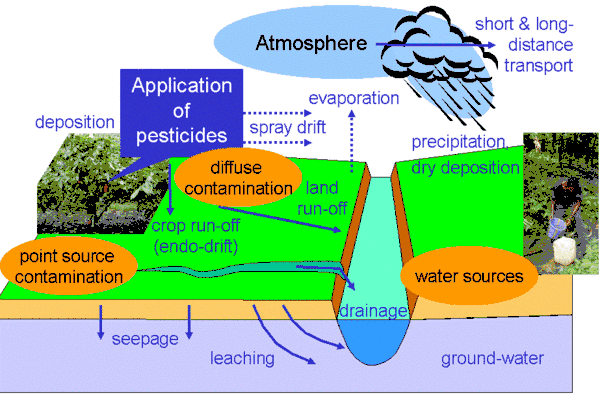
In the United States, pesticides were found to pollute every stream and over 90% of wells sampled in a study by the US Geological Survey.[41] Pesticide residues have also been found in rain and groundwater.[42] Studies by the UK government showed that pesticide concentrations exceeded those allowable for drinking water in some samples of river water and groundwater.[43]
Pesticide impacts on aquatic systems are often studied using a hydrology transport model to study movement and fate of chemicals in rivers and streams. As early as the 1970s quantitative analysis of pesticide runoff was conducted in order to predict amounts of pesticide that would reach surface waters.[44]
There are four major routes through which pesticides reach the water: it may drift outside of the intended area when it is sprayed, it may percolate, or leach through the soil, it may be carried to the water as runoff, or it may be spilled, for example accidentally or through neglect.[45] They may also be carried to water by eroding soil.[46] Factors that affect a pesticide's ability to contaminate water include its water solubility, the distance from an application site to a body of water, weather, soil type, presence of a growing crop, and the method used to apply the chemical.[47]
United States regulations
In the US, maximum limits of allowable concentrations for individual pesticides in drinking water are set by the Environmental Protection Agency (EPA) for public water systems.[42][47] (There are no federal standards for private wells.[48]) Ambient water quality standards for pesticide concentrations in water bodies are principally developed by state environmental agencies, with EPA oversight. These standards may be issued for individual water bodies, or may apply statewide.[49][50]
United Kingdom regulations
The United Kingdom sets Environmental Quality Standards (EQS), or maximum allowable concentrations of some pesticides in bodies of water above which toxicity may occur.[51]
European Union regulations
The European Union also regulates maximum concentrations of pesticides in water.[51]
Soil
The extensive use of pesticides in agricultural production can degrade and damage the community of microorganisms living in the soil, particularly when these chemicals are overused or misused as chemical compounds build up in the soil.[52] The full impact of pesticides on soil microorganisms is still not entirely understood; many studies have found deleterious effects of pesticides on soil microorganisms and biochemical processes, while others have found that the residue of some pesticides can be degraded and assimilated by microorganisms.[53] The effect of pesticides on soil microorganisms is impacted by the persistence, concentration, and toxicity of the applied pesticide, in addition to various environmental factors.[54] This complex interaction of factors makes it difficult to draw definitive conclusions about the interaction of pesticides with the soil ecosystem. In general, long-term pesticide application can disturb the biochemical processes of nutrient cycling.[53]
Many of the chemicals used in pesticides are persistent soil contaminants, whose impact may endure for decades and adversely affect soil conservation.[55]
The use of pesticides decreases the general biodiversity in the soil. Not using the chemicals results in higher soil quality,[56] with the additional effect that more organic matter in the soil allows for higher water retention.[42] This helps increase yields for farms in drought years, when organic farms have had yields 20-40% higher than their conventional counterparts.[57] A smaller content of organic matter in the soil increases the amount of pesticide that will leave the area of application, because organic matter binds to and helps break down pesticides.[42]
Degradation and sorption are both factors which influence the persistence of pesticides in soil. Depending on the chemical nature of the pesticide, such processes control directly the transportation from soil to water, and in turn to air and our food. Breaking down organic substances, degradation, involves interactions among microorganisms in the soil. Sorption affects bioaccumulation of pesticides which are dependent on organic matter in the soil. Weak organic acids have been shown to be weakly sorbed by soil, because of pH and mostly acidic structure. Sorbed chemicals have been shown to be less accessible to microorganisms. Aging mechanisms are poorly understood but as residence times in soil increase, pesticide residues become more resistant to degradation and extraction as they lose biological activity.[58]
Effect on plants
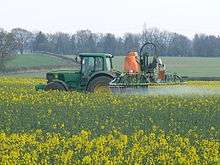
Nitrogen fixation, which is required for the growth of higher plants, is hindered by pesticides in soil.[59] The insecticides DDT, methyl parathion, and especially pentachlorophenol have been shown to interfere with legume-rhizobium chemical signaling.[59] Reduction of this symbiotic chemical signaling results in reduced nitrogen fixation and thus reduced crop yields.[59] Root nodule formation in these plants saves the world economy $10 billion in synthetic nitrogen fertilizer every year.[60]
Pesticides can kill bees and are strongly implicated in pollinator decline, the loss of species that pollinate plants, including through the mechanism of Colony Collapse Disorder,[61][62][63][64] in which worker bees from a beehive or western honey bee colony abruptly disappear. Application of pesticides to crops that are in bloom can kill honeybees,[34] which act as pollinators. The USDA and USFWS estimate that US farmers lose at least $200 million a year from reduced crop pollination because pesticides applied to fields eliminate about a fifth of honeybee colonies in the US and harm an additional 15%.[1]
On the other side, pesticides have some direct harmful effect on plant including poor root hair development, shoot yellowing and reduced plant growth.[65]
Effect on animals
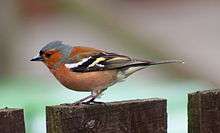
Many kinds of animals are harmed by pesticides, leading many countries to regulate pesticide usage through Biodiversity Action Plans.
Animals including humans may be poisoned by pesticide residues that remain on food, for example when wild animals enter sprayed fields or nearby areas shortly after spraying.[38]
Pesticides can eliminate some animals' essential food sources, causing the animals to relocate, change their diet or starve. Residues can travel up the food chain; for example, birds can be harmed when they eat insects and worms that have consumed pesticides.[34] Earthworms digest organic matter and increase nutrient content in the top layer of soil. They protect human health by ingesting decomposing litter and serving as bioindicators of soil activity. Pesticides have had harmful effects on growth and reproduction on earthworms.[66] Some pesticides can bioaccumulate, or build up to toxic levels in the bodies of organisms that consume them over time, a phenomenon that impacts species high on the food chain especially hard.[34]
Birds
.svg.png)
The US Fish and Wildlife Service estimates that 72 million birds are killed by pesticides in the United States each year.[68] Bald eagles are common examples of nontarget organisms that are impacted by pesticide use. Rachel Carson's book Silent Spring dealt with damage to bird species due to pesticide bioaccumulation. There is evidence that birds are continuing to be harmed by pesticide use. In the farmland of the United Kingdom, populations of ten different bird species declined by 10 million breeding individuals between 1979 and 1999, allegedly from loss of plant and invertebrate species on which the birds feed. Throughout Europe, 116 species of birds were threatened as of 1999. Reductions in bird populations have been found to be associated with times and areas in which pesticides are used.[69] DDE-induced egg shell thinning has especially affected European and North American bird populations.[70] From 1990 to 2014 the number of common farmland birds has declined in the European Union as a whole and in France, Belgium and Sweden; in Germany, which relies more on organic farming and less on pesticides the decline has been slower; in Switzerland, which does not rely much on intensive agriculture, after a decline in the early 2000s the level has returned to the one of 1990.[67] In another example, some types of fungicides used in peanut farming are only slightly toxic to birds and mammals, but may kill earthworms, which can in turn reduce populations of the birds and mammals that feed on them.[38]
Some pesticides come in granular form. Wildlife may eat the granules, mistaking them for grains of food. A few granules of a pesticide may be enough to kill a small bird.[38] Herbicides may endanger bird populations by reducing their habitat.[38]
Aquatic life
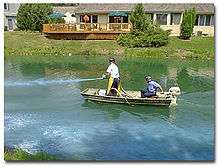

Fish and other aquatic biota may be harmed by pesticide-contaminated water.[71] Pesticide surface runoff into rivers and streams can be highly lethal to aquatic life, sometimes killing all the fish in a particular stream.[72]
Application of herbicides to bodies of water can cause fish kills when the dead plants decay and consume the water's oxygen, suffocating the fish. Herbicides such as copper sulfate that are applied to water to kill plants are toxic to fish and other water animals at concentrations similar to those used to kill the plants. Repeated exposure to sublethal doses of some pesticides can cause physiological and behavioral changes that reduce fish populations, such as abandonment of nests and broods, decreased immunity to disease and decreased predator avoidance.[71]
Application of herbicides to bodies of water can kill plants on which fish depend for their habitat.[71]
Pesticides can accumulate in bodies of water to levels that kill off zooplankton, the main source of food for young fish.[73] Pesticides can also kill off insects on which some fish feed, causing the fish to travel farther in search of food and exposing them to greater risk from predators.[71]
The faster a given pesticide breaks down in the environment, the less threat it poses to aquatic life. Insecticides are typically more toxic to aquatic life than herbicides and fungicides.[71]
Amphibians
In the past several decades, amphibian populations have declined across the world, for unexplained reasons which are thought to be varied but of which pesticides may be a part.[74]
Pesticide mixtures appear to have a cumulative toxic effect on frogs. Tadpoles from ponds containing multiple pesticides take longer to metamorphose and are smaller when they do, decreasing their ability to catch prey and avoid predators.[75] Exposing tadpoles to the organochloride endosulfan at levels likely to be found in habitats near fields sprayed with the chemical kills the tadpoles and causes behavioral and growth abnormalities.[76]
The herbicide atrazine can turn male frogs into hermaphrodites, decreasing their ability to reproduce.[75] Both reproductive and nonreproductive effects in aquatic reptiles and amphibians have been reported. Crocodiles, many turtle species and some lizards lack sex-distinct chromosomes until after fertilization during organogenesis, depending on temperature. Embryonic exposure in turtles to various PCBs causes a sex reversal. Across the United States and Canada disorders such as decreased hatching success, feminization, skin lesions, and other developmental abnormalities have been reported.[70]
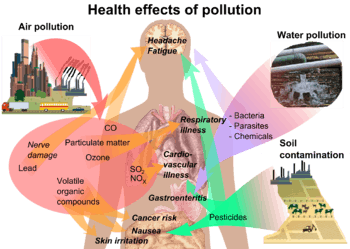
Humans
Pesticides can enter the body through inhalation of aerosols, dust and vapor that contain pesticides; through oral exposure by consuming food/water; and through skin exposure by direct contact.[77] Pesticides secrete into soils and groundwater which can end up in drinking water, and pesticide spray can drift and pollute the air.
The effects of pesticides on human health depend on the toxicity of the chemical and the length and magnitude of exposure.[78] Farm workers and their families experience the greatest exposure to agricultural pesticides through direct contact. Every human contains pesticides in their fat cells.
Children are more susceptible and sensitive to pesticides,[77] because they are still developing and have a weaker immune system than adults. Children may be more exposed due to their closer proximity to the ground and tendency to put unfamiliar objects in their mouth. Hand to mouth contact depends on the child's age, much like lead exposure. Children under the age of six months are more apt to experience exposure from breast milk and inhalation of small particles. Pesticides tracked into the home from family members increase the risk of exposure. Toxic residue in food may contribute to a child’s exposure.[79] The chemicals can bioaccumulate in the body over time.
Exposure effects can range from mild skin irritation to birth defects, tumors, genetic changes, blood and nerve disorders, endocrine disruption, coma or death.[78] Developmental effects have been associated with pesticides. Recent increases in childhood cancers in throughout North America, such as leukemia, may be a result of somatic cell mutations.[80] Insecticides targeted to disrupt insects can have harmful effects on mammalian nervous systems. Both chronic and acute alterations have been observed in exposes. DDT and its breakdown product DDE disturb estrogenic activity and possibly lead to breast cancer. Fetal DDT exposure reduces male penis size in animals and can produce undescended testicles. Pesticide can affect fetuses in early stages of development, in utero and even if a parent was exposed before conception. Reproductive disruption has the potential to occur by chemical reactivity and through structural changes.[81]
Persistent organic pollutants
Persistent organic pollutants (POPs) are compounds that resist degradation and thus remain in the environment for years. Some pesticides, including aldrin, chlordane, DDT, dieldrin, endrin, heptachlor, hexachlorobenzene, mirex and toxaphene, are considered POPs. Some POPs have the ability to volatilize and travel great distances through the atmosphere to become deposited in remote regions. Such chemicals may have the ability to bioaccumulate and biomagnify and can biomagnify (i.e. become more concentrated) up to 70,000 times their original concentrations.[82] POPs can affect non-target organisms in the environment and increase risk to humans[83] by disruption in the endocrine, reproductive, and respiratory systems.[82]
Pest resistance
Pests may evolve to become resistant to pesticides. Many pests will initially be very susceptible to pesticides, but following mutations in their genetic makeup become resistant and survive to reproduce.
Resistance is commonly managed through pesticide rotation, which involves alternating among pesticide classes with different modes of action to delay the onset of or mitigate existing pest resistance.[84]
Pest rebound and secondary pest outbreaks
Non-target organisms can also be impacted by pesticides. In some cases, a pest insect that is controlled by a beneficial predator or parasite can flourish should an insecticide application kill both pest and beneficial populations. A study comparing biological pest control and pyrethroid insecticide for diamondback moths, a major cabbage family insect pest, showed that the pest population rebounded due to loss of insect predators, whereas the biocontrol did not show the same effect.[85] Likewise, pesticides sprayed to control mosquitoes may temporarily depress mosquito populations, they may result in a larger population in the long run by damaging natural controls.[34] This phenomenon, wherein the population of a pest species rebounds to equal or greater numbers than it had before pesticide use, is called pest resurgence and can be linked to elimination of its predators and other natural enemies.[86]
Loss of predator species can also lead to a related phenomenon called secondary pest outbreaks, an increase in problems from species that were not originally a problem due to loss of their predators or parasites.[86] An estimated third of the 300 most damaging insects in the US were originally secondary pests and only became a major problem after the use of pesticides.[1] In both pest resurgence and secondary outbreaks, their natural enemies were more susceptible to the pesticides than the pests themselves, in some cases causing the pest population to be higher than it was before the use of pesticide.[86]
Eliminating pesticides
Many alternatives are available to reduce the effects pesticides have on the environment. Alternatives include manual removal, applying heat, covering weeds with plastic, placing traps and lures, removing pest breeding sites, maintaining healthy soils that breed healthy, more resistant plants, cropping native species that are naturally more resistant to native pests and supporting biocontrol agents such as birds and other pest predators.[87] In the United States, conventional pesticide use peaked in 1979, and by 2007, had been reduced by 25 percent from the 1979 peak level,[88] while US agricultural output increased by 43 percent over the same period.[89]
Biological controls such as resistant plant varieties and the use of pheromones, have been successful and at times permanently resolve a pest problem.[90] Integrated Pest Management (IPM) employs chemical use only when other alternatives are ineffective. IPM causes less harm to humans and the environment. The focus is broader than on a specific pest, considering a range of pest control alternatives.[91] Biotechnology can also be an innovative way to control pests. Strains can be genetically modified (GM) to increase their resistance to pests.[90] The same techniques can be used to increase pesticide resistance and was employed by Monsanto to create glyphosate-resistant strains of major crops. In the United States in 2010, 70% of all the corn that was planted was resistant to glyphosate; 78% of cotton, and 93% of all soybeans.[92]
References
- George Tyler Miller (1 January 2004). Sustaining the Earth: An Integrated Approach. Thomson/Brooks/Cole. pp. 211–216. ISBN 978-0-534-40088-0.
- Tashkent (1998), Part 75. Conditions and provisions for developing a national strategy for biodiversity conservation Archived 2007-10-13 at the Wayback Machine. Biodiversity Conservation National Strategy and Action Plan of Republic of Uzbekistan. Prepared by the National Biodiversity Strategy Project Steering Committee with the Financial Assistance of The Global Environmental Facility (GEF) and Technical Assistance of United Nations Development Programme (UNDP). Retrieved on September 17, 2007.
- Damalas, C. A.; Eleftherohorinos, I. G. (2011). "Pesticide Exposure, Safety Issues, and Risk Assessment Indicators". International Journal of Environmental Research and Public Health. 8 (12): 1402–19. doi:10.3390/ijerph8051402. PMC 3108117. PMID 21655127.
- Lamberth, C.; Jeanmart, S.; Luksch, T.; Plant, A. (2013). "Current Challenges and Trends in the Discovery of Agrochemicals". Science. 341 (6147): 742–6. doi:10.1126/science.1237227. PMID 23950530.
- Tosi, S.; Costa, C.; Vesco, U.; Quaglia, G.; Guido, G. (2018). "A survey of honey bee-collected pollen reveals widespread contamination by agricultural pesticides". The Science of the Total Environment. 615: 208–218. doi:10.1016/j.scitotenv.2017.09.226. PMID 28968582.
- Garzia, Nichole A.; Spinelli, John J.; Gotay, Carolyn C.; Teschke, Kay (2018-07-03). "Literature review: dermal monitoring data for pesticide exposure assessment of farm workers". Journal of Agromedicine. 23 (3): 187–214. doi:10.1080/1059924x.2018.1448734. ISSN 1059-924X. PMID 30047858.
- Kohler, H. -R.; Triebskorn, R. (2013). "Wildlife Ecotoxicology of Pesticides: Can We Track Effects to the Population Level and Beyond?". Science. 341 (6147): 759–765. doi:10.1126/science.1237591. PMID 23950533. S2CID 206548843.
- apvma.gov.au: "Tebufenozide in the product Mimic 700 WP Insecticide, Mimic 240 SC Insecticide"
- Fantke, Peter; Gillespie, Brenda W.; Juraske, Ronnie; Jolliet, Olivier (2014). "Estimating Half-Lives for Pesticide Dissipation from Plants". Environmental Science & Technology. 48: 8588–8602. doi:10.1021/es500434p.
- npic.orst.edu: " Pesticide Half-life Fact Sheet", 2015
- npic.orst.edu: "What Happens to Pesticides Released in the Environment?", 20 Sep 2017
- usu.edu: "PESTICIDE ADSORPTION AND HALF-LIFE", October 2004
- usu.edu: "PESTICIDE ADSORPTION AND HALF-LIFE", February 1999
- Turusov, V; Rakitsky, V; Tomatis, L (2002). "Dichlorodiphenyltrichloroethane (DDT): Ubiquity, persistence, and risks". Environmental Health Perspectives. 110 (2): 125–8. doi:10.1289/ehp.02110125. PMC 1240724. PMID 11836138.
- Rattner, B. A. (2009). "History of wildlife toxicology". Ecotoxicology. 18 (7): 773–783. doi:10.1007/s10646-009-0354-x. PMID 19533341.
- Fleischli, M. A.; Franson, J. C.; Thomas, N. J.; Finley, D. L.; Riley, W. (2004). "Avian Mortality Events in the United States Caused by Anticholinesterase Pesticides: A Retrospective Summary of National Wildlife Health Center Records from 1980 to 2000". Archives of Environmental Contamination and Toxicology. 46 (4): 542–50. CiteSeerX 10.1.1.464.4457. doi:10.1007/s00244-003-3065-y. PMID 15253053.
- Crain, D. A.; Guillette Jr, L. J. (1998). "Reptiles as models of contaminant-induced endocrine disruption". Animal Reproduction Science. 53 (1–4): 77–86. doi:10.1016/s0378-4320(98)00128-6. PMID 9835368.
- Galloway, T. S.; Depledge, M. H. (2001). "Immunotoxicity in Invertebrates: Measurement and Ecotoxicological Relevance". Ecotoxicology. 10 (1): 5–23. doi:10.1023/A:1008939520263. PMID 11227817.
- Dzugan, S. A.; Rozakis, G. W.; Dzugan, K. S.; Emhof, L; Dzugan, S. S.; Xydas, C; Michaelides, C; Chene, J; Medvedovsky, M (2011). "Correction of steroidopenia as a new method of hypercholesterolemia treatment". Neuro Endocrinology Letters. 32 (1): 77–81. PMID 21407165.
- Galloway, T.; Handy, R. (2003). "Immunotoxicity of Organophosphorous Pesticides". Ecotoxicology. 12 (1–4): 345–363. doi:10.1023/A:1022579416322. PMID 12739880.
- Story, P.; Cox, M. (2001). "Review of the effects of organophosphorus and carbamate insecticides on vertebrates. Are there implications for locust management in Australia?". Wildlife Research. 28 (2): 179. doi:10.1071/WR99060.
- Rohr, J. R.; Schotthoefer, A. M.; Raffel, T. R.; Carrick, H. J.; Halstead, N.; Hoverman, J. T.; Johnson, C. M.; Johnson, L. B.; Lieske, C.; Piwoni, M. D.; Schoff, P. K.; Beasley, V. R. (2008). "Agrochemicals increase trematode infections in a declining amphibian species". Nature. 455 (7217): 1235–1239. doi:10.1038/nature07281. PMID 18972018.
- Lin, P. C.; Lin, H. J.; Liao, Y. Y.; Guo, H. R.; Chen, K. T. (2013). "Acute poisoning with neonicotinoid insecticides: A case report and literature review". Basic & Clinical Pharmacology & Toxicology. 112 (4): 282–6. doi:10.1111/bcpt.12027. PMID 23078648.
- Gill, R. J.; Ramos-Rodriguez, O.; Raine, N. E. (2012). "Combined pesticide exposure severely affects individual- and colony-level traits in bees". Nature. 491 (7422): 105–108. doi:10.1038/nature11585. PMC 3495159. PMID 23086150.
- Henry, M.; Beguin, M.; Requier, F.; Rollin, O.; Odoux, J. -F.; Aupinel, P.; Aptel, J.; Tchamitchian, S.; Decourtye, A. (2012). "A Common Pesticide Decreases Foraging Success and Survival in Honey Bees". Science. 336 (6079): 348–350. doi:10.1126/science.1215039. PMID 22461498.
- Cresswell, J. E.; Thompson, H. M. (2012). "Comment on "A Common Pesticide Decreases Foraging Success and Survival in Honey Bees"". Science. 337 (6101): 1453. doi:10.1126/science.1224618. PMID 22997307.
- Tosi, S.; Nieh, J. C. (2019-04-10). "Lethal and sublethal synergistic effects of a new systemic pesticide, flupyradifurone (Sivanto®), on honeybees". Proceedings of the Royal Society B: Biological Sciences. 286 (1900): 20190433. doi:10.1098/rspb.2019.0433. PMC 6501679. PMID 30966981.
- Tong, Linda; Nieh, James C.; Tosi, Simone (2019-12-01). "Combined nutritional stress and a new systemic pesticide (flupyradifurone, Sivanto®) reduce bee survival, food consumption, flight success, and thermoregulation". Chemosphere. 237: 124408. doi:10.1016/j.chemosphere.2019.124408. ISSN 0045-6535.
- Pisa, Lennard; Goulson, Dave; Yang, En-Cheng; Gibbons, David; Sánchez-Bayo, Francisco; Mitchell, Edward; Aebi, Alexandre; van der Sluijs, Jeroen; MacQuarrie, Chris J. K.; Giorio, Chiara; Long, Elizabeth Yim (2017-11-09). "An update of the Worldwide Integrated Assessment (WIA) on systemic insecticides. Part 2: impacts on organisms and ecosystems". Environmental Science and Pollution Research. doi:10.1007/s11356-017-0341-3. ISSN 1614-7499.
- Biondi, A.; Mommaerts, V.; Smagghe, G.; Viñuela, E.; Zappalà, L.; Desneux, N. (2012). "The non-target impact of spinosyns on beneficial arthropods". Pest Management Science. 68 (12): 1523–1536. doi:10.1002/ps.3396. PMID 23109262.
- Freemark, K. (1995). "Impacts of agricultural herbicide use on terrestrial wildlife in temperate landscapes: A review with special reference to North America". Agriculture, Ecosystems & Environment. 52 (2–3): 67–91. doi:10.1016/0167-8809(94)00534-L.
- Cahill, J. F.; Elle, E.; Smith, G. R.; Shore, B. H. (2008). "Disruption of a Belowground Mutualism Alters Interactions Between Plants and Their Floral Visitors". Ecology. 89 (7): 1791–1801. doi:10.1890/07-0719.1. PMID 18705367.
- Newton, I. (2004). "The recent declines of farmland bird populations in Britain: An appraisal of causal factors and conservation actions". Ibis. 146 (4): 579–600. doi:10.1111/j.1474-919X.2004.00375.x.
- Cornell University. Pesticides in the environment Archived 2009-06-05 at the Wayback Machine. Pesticide fact sheets and tutorial, . Pesticide Safety Education Program. Retrieved on 2007-10-11.
- National Park Service. US Department of the Interior. (August 1, 2006), Sequoia & Kings Canyon National Park: Air quality -- Airborne synthetic chemicals. Nps.gov. Retrieved on September 19, 2007.
- "PRN 2001-X Draft: Spray and Dust Drift Label Statements for Pesticide Products". Pesticide Registration. Washington, DC: US Environmental Protection Agency (EPA). Retrieved 2007-09-19.
- Environment Canada (September–October 2001), Agricultural pesticides and the atmosphere Archived 2006-09-24 at the Wayback Machine. Retrieved on 2007-10-12.
- Palmer, WE, Bromley, PT, and Brandenburg, RL. Wildlife & pesticides - Peanuts. North Carolina Cooperative Extension Service. Retrieved on 2007-10-11.
- Science Daily (November 19, 1999), Evergreens help block spread of pesticide from crop fields. Sciencedaily.com. Retrieved on September 19, 2007.
- UC IPM Online. (August 11, 2006), What’s up, Doc? Maybe less air pollution. Statewide IPM Program, Agriculture and Natural Resources, University of California. Ipm.ucdavis.edu. Retrieved on 2007-10-15.
- Gillion, RJ; Barbash, JE; Crawford, GG; Hamilton, PA; Martin, JD; Nakagaki, N; Nowell, LH; Scott, JC; Stackelberg, PE; Thelin, GP; Wolock, DM (2007-02-15) [2006]. "1. Overview of Findings and Implications". Pesticides in the Nation's Streams and Ground Water, 1992–2001 (Report). The Quality of Our Nation’s Waters. Reston, VA: US Geological Survey. p. 4. Circular 1291.
- Kellogg RL, Nehring R, Grube A, Goss DW, and Plotkin S (February 2000), Environmental indicators of pesticide leaching and runoff from farm fields Archived June 18, 2002, at the Wayback Machine. United States Department of Agriculture Natural Resources Conservation Service. Retrieved on 2007-10-03.
- Bingham, S (2007), Pesticides in rivers and groundwater Archived 2009-03-02 at the Wayback Machine. Environment Agency, UK. Retrieved on 2007-10-12.
- Hogan,, CM, Patmore L, Latshaw, G, Seidman, H, et al. (1973), Computer modeling of pesticide transport in soil for five instrumented watersheds, U.S. Environmental Protection Agency Southeast Water laboratory, Athens, Ga. by ESL Inc., Sunnyvale, California.
- States of Jersey (2007), Environmental protection and pesticide use Archived 2006-08-25 at the Wayback Machine. Retrieved on 2007-10-10.
- Papendick, RI; Elliott, LF; Dahlgren, RB (1986). "Environmental consequences of modern production agriculture: How can alternative agriculture address these issues and concerns?". American Journal of Alternative Agriculture. 1 (1): 3–10. doi:10.1017/s0889189300000722.
- Pedersen, TL (June 1997), Pesticide residues in drinking water. extoxnet.orst.edu. Retrieved on September 15, 2007.
- "Private Drinking Water Wells". EPA. 2016-11-15.
- "How Are Water Quality Standards Developed?". Standards for Water Body Health. EPA. 2016-11-03.
- "State-Specific Water Quality Standards Effective under the Clean Water Act (CWA)". EPA. 2016-12-01.
- Bingham, S (2007), Pesticides exceeding environmental quality standards (EQS) Archived 2008-06-17 at the Wayback Machine. The Environment Agency, UK. Retrieved on 2007-10-12.
- Environmental, Oakshire. "How To Test For Agricultural Land Contamination". Oakshire Environmental. Retrieved 2020-01-23.
- Hussain S, Siddique T, Saleem M, Arshad M, Khalid A (2009). Chapter 5: Impact of Pesticides on Soil Microbial Diversity, Enzymes, and Biochemical Reactions. Advances in Agronomy. 102. pp. 159–200. doi:10.1016/s0065-2113(09)01005-0. ISBN 9780123748188.
- Abdel-Mallek AY, Moharram AM, Abdel-Kader MI, Omar SA (1994). "Effect of soil treatment with the organophosphorus insecticide Profenfos on the fungal flora and some microbial activities". Microbiological Research. 149 (2): 167–171. doi:10.1016/s0944-5013(11)80114-x. PMID 7921896.
- "Sources of common contaminants and their health effects". Emergency Response Program. EPA. Archived from the original on 2008-12-20. Retrieved 2007-10-10.
- Johnston, AE (1986). "Soil organic-matter, effects on soils and crops". Soil Use Management. 2 (3): 97–105. doi:10.1111/j.1475-2743.1986.tb00690.x.
- Lotter DW, Seidel R, Liebhardt W (2003). "The performance of organic and conventional cropping systems in an extreme climate year". American Journal of Alternative Agriculture. 18 (3): 146–154. doi:10.1079/AJAA200345.
- Arias-Estévez, Manuel; Eugenio López-Periago; Elena Martínez-Carballo; Jesús Simal-Gándara; Juan-Carlos Mejuto; Luis García-Río (February 2008). "The mobility and degradation of pesticides in soils and the pollution of groundwater resources" (PDF). Agriculture, Ecosystems & Environment. 123 (4): 247–260. doi:10.1016/j.agee.2007.07.011. ISSN 0167-8809. Retrieved 2011-11-10.
- Rockets, Rusty (June 8, 2007), Down On The Farm? Yields, Nutrients And Soil Quality. Scienceagogo.com. Retrieved on September 15, 2007.
- Fox, JE; Gulledge, J; Engelhaupt, E; Burrow, ME & McLachlan, JA (2007). "Pesticides reduce symbiotic efficiency of nitrogen-fixing rhizobia and host plants". Proceedings of the National Academy of Sciences of the USA. 104 (24): 10282–10287. doi:10.1073/pnas.0611710104. PMC 1885820. PMID 17548832.
- Hackenberg D (2007-03-14). "Letter from David Hackenberg to American growers from March 14, 2007". Plattform Imkerinnen — Austria. Archived from the original on 2007-06-14. Retrieved 2007-03-27.
- Wells, M (March 11, 2007). "Vanishing bees threaten US". www.bbc.co.uk. BBC News. Retrieved 2007-09-19.
- Haefeker, Walter (2000-08-12). "Betrayed and sold out – German bee monitoring". Retrieved 2007-10-10.
- Zeissloff, Eric (2001). "Schadet imidacloprid den bienen" (in German). Retrieved 2007-10-10.
- Walley F, Taylor A and Lupwayi (2006) Herbicide effects on pulse crop nodulation and nitrogen fixation. FarmTech 2006 Proceedings 121-123.
- Yasmin, S.; d'Souza, D. (2010). "Effects of Pesticides on the Growth and Reproduction of Earthworm: A Review". Applied and Environmental Soil Science. 2010: 1–9. doi:10.1155/2010/678360.
- Duval, Guillaume (11 April 2018). "Birds - collateral victims of intensive agriculture". Alternatives Economiques/EDJNet. Retrieved 24 August 2018.
- Fimrite, Peter (June 27, 2011). "Suit says EPA fails to shield species from poisons". The San Francisco Chronicle.
- Kerbs JR, Wilson JD, Bradbury RB, and Siriwardena GM (August 12, 1999), The second silent spring Archived 2008-04-06 at the Wayback Machine. Commentary in Nature, Volume 400, Pages 611-612.
- Vos, J. G.; Dybing, E; Greim, H. A.; Ladefoged, O; Lambré, C; Tarazona, J. V.; Brandt, I; Vethaak, A. D. (2000). "Health effects of endocrine-disrupting chemicals on wildlife, with special reference to the European situation". Critical Reviews in Toxicology. 30 (1): 71–133. doi:10.1080/10408440091159176. PMID 10680769.
- Helfrich, LA, Weigmann, DL, Hipkins, P, and Stinson, ER (June 1996), Pesticides and aquatic animals: A guide to reducing impacts on aquatic systems Archived 2009-03-05 at the Wayback Machine. Virginia Cooperative Extension. Retrieved on 2007-10-14.
- Toughill K (1999), The summer the rivers died: Toxic runoff from potato farms is poisoning P.E.I. Archived January 18, 2008, at the Wayback Machine Originally published in Toronto Star Atlantic Canada Bureau. Retrieved on September 17, 2007.
- Pesticide Action Network North America (June 4, 1999), Pesticides threaten birds and fish in California Archived 2012-02-18 at the Wayback Machine. PANUPS. Retrieved on 2007-09-17.
- Cone M (December 6, 2000), A wind-borne threat to Sierra frogs: A study finds that pesticides used on farms in the San Joaquin Valley damage the nervous systems of amphibians in Yosemite and elsewhere Archived 2015-11-02 at the Wayback Machine. L.A. Times Retrieved on September 17, 2007.
- Science Daily (February 3, 2006), Pesticide combinations imperil frogs, probably contribute to amphibian decline. Sciencedaily.com. Retrieved on 2007-10-16.
- Raloff, J (September 5, 1998) Common pesticide clobbers amphibians. Science News, Volume 154, Number 10, Page 150. Retrieved on 2007-10-15.
- California Department of Pesticide Regulation (2008), "What are the Potential Health Effects of Pesticides?" Community Guide to Recognizing and Reporting Pesticide Problems. Sacramento, CA. Pages 27-29.
- Lorenz, Eric S. (2009). "Potential Health Effects of Pesticides" (PDF). Ag Communications and Marketing: 1–8. Archived from the original (PDF) on 2013-08-11. Retrieved February 2014. Check date values in:
|accessdate=(help) - Du Toit, D. F. (1992). "Pancreatic transplantation". South African Medical. 81 (8): 432–3. PMID 1566222.
- Crawford, S. L.; Fiedler, E. R. (1992). "Childhood physical and sexual abuse and failure to complete military basic training". Military Medicine. 157 (12): 645–8. doi:10.1093/milmed/157.12.645. PMID 1470375.
- Hodgson, E; Levi, P. E. (1996). "Pesticides: An important but underused model for the environmental health sciences". Environmental Health Perspectives. 104 Suppl 1: 97–106. doi:10.1289/ehp.96104s197. PMC 1469573. PMID 8722114.
- Ritter L, Solomon KR, and Forget J, Stemeroff M, and O'Leary C. Persistent organic pollutants: An Assessment Report on: DDT, Aldrin, Dieldrin, Endrin, Chlordane, Heptachlor, Hexachlorobenzene, Mirex, Toxaphene, Polychlorinated Biphenyls, Dioxins and Furans Archived 2007-09-26 at the Wayback Machine. Prepared for The International Programme on Chemical Safety (IPCS), within the framework of the Inter-Organization Programme for the Sound Management of Chemicals (IOMC). Retrieved on September 16, 2007.
- Centers for Disease Control and Prevention. Pesticides Archived 2007-10-13 at the Wayback Machine. cdc.gov. Retrieved on September 15, 2007.
- Graeme Murphy (December 1, 2005), Resistance Management - Pesticide Rotation Archived October 13, 2007, at the Wayback Machine. Ontario Ministry of Agriculture, Food and Rural Affairs. Retrieved on September 15, 2007.
- Muckenfuss AE, Shepard BM, Ferrer ER, Natural mortality of diamondback moth in coastal South Carolina Archived 2012-02-15 at the Wayback Machine Clemson University, Coastal Research and Education Center.
- Howell V. Daly; John T. Doyen; Alexander H. Purcell (1 January 1998). Introduction to Insect Biology and Diversity. Oxford University Press. pp. 279–300. ISBN 978-0-19-510033-4.
- "Take Action! How to Eliminate Pesticide Use." (2003) National Audubon Society. Pages 1-3.
- EPA. 2011. Pesticides industry sales and usage; 2006 and 2007 market estimates. "Archived copy" (PDF). Archived from the original (PDF) on 2015-03-18. Retrieved 2014-07-24.CS1 maint: archived copy as title (link)
- USDA ERS. 2013. Table 1. Indices of farm output, input and total factor productivity for the United States, 1948-2011. (last update 9/27/2013) http://www.ers.usda.gov/data-products/agricultural-productivity-in-the-us.aspx#28247
- Lewis, W. J., J. C. van Lenteren, Sharad C. Phatak, and J. H. Tumlinson, III. "A total system approach to sustainable pest management." The National Academy of Sciences 13 August 1997. Web of Science.
- Thad Godish (2 November 2000). Indoor Environmental Quality. CRC Press. pp. 325–326. ISBN 978-1-4200-5674-7.
- Acreage NASS National Agricultural Statistics Board annual report, June 30, 2010. Retrieved August 26, 2012.
External links
- National Pesticide Information Center - What happens to pesticides released in the environment?
- Streaming online video about efforts to reduce pesticide use in rice in Bangladesh. Windows Media Player , RealPlayer
- Reptile Amphibian & Pesticide (RAP) Database
- EXtension TOXicology NETwork (Extoxnet) - pesticide information profiles. Environmental and health information broken down by type of pesticide